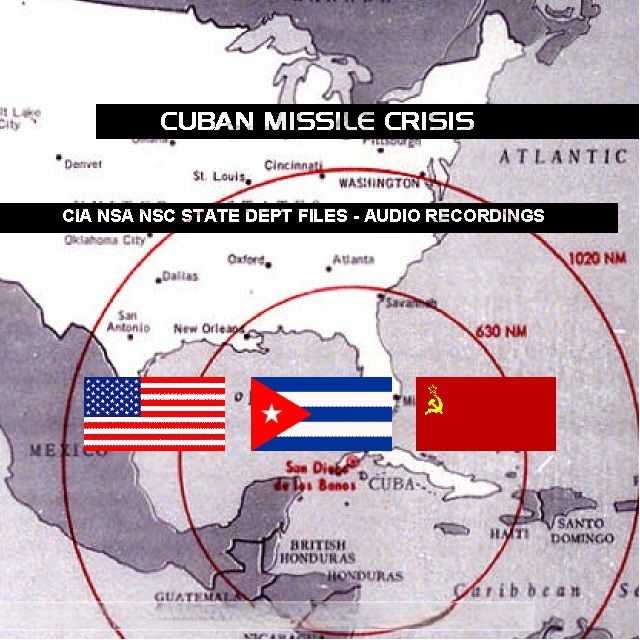
Cuban Missile Crisis Presidential – CIA – NSA – NSC – State Dept Files – Audio Recordings
$19.50
Description
Cuban Missile Crisis: A Definitive Timeline and Cast
1960
- Mid-1960: Agreements signed between the Soviet Union and Czechoslovakia with Cuba, followed by a secret arms buildup in Cuba sponsored by the Soviets and their satellites. NSA intercepts begin to show suspicious, blank cargo manifests on Soviet ships headed for Havana.
1961
- Early 1961: The Soviet ship Nikolay Burdenko arrives at Mariel, Cuba. NSA intercepts indicate secret unloading operations and discussions among Cubans about the arrival of tanks.
August 1962
- Evening of August 23: Director of Central Intelligence (DCI) John A. McCone leaves Washington for his honeymoon in France, remaining out of town until September 23. Deputy Director of Central Intelligence (DDCI), Lt. Gen. Marshall S. Carter, serves as Acting Director.
September 1962
- September 17: A critical event, according to Colonel Marcus Glenn’s 2017 study, occurs that highlights a failure of U.S. nuclear deterrence. This event, though not explicitly detailed in the provided excerpts beyond its date, is presented as an early indicator of a breakdown in deterrence prior to the overt crisis.
- September 23: DCI John A. McCone returns to Washington from his honeymoon.
October 1962
- Evening of October 11: DCI John A. McCone leaves for Los Angeles on business.
- Late October 14: DCI John A. McCone returns to Washington from Los Angeles.
- Afternoon of October 15: DCI John A. McCone returns to the West Coast following news of his stepson’s death.
- October 15: The Cuban Missile Crisis officially begins, as referenced by Major Timothy R. Newkirk’s 2016 report.
- Evening of October 16: The discovery of missiles in Cuba brings DCI John A. McCone back to Washington, where he remains for the duration of the crisis. Audio recordings confirm a CIA briefing of President Kennedy about U-2 reconnaissance images showing Soviet medium-range ballistic missiles (MRBMs) installed in Cuba.
- October 17: President Kennedy records a Dictaphone review of the situation and discussions from the previous day with his advisors.
- October 18: Recordings of ExComm (Executive Committee of the National Security Council) meetings begin, involving President Kennedy and key advisors discussing the crisis. A memorandum from Attorney General Robert F. Kennedy to Secretary of State Dean Rusk summarizes a meeting between Kennedy and Soviet Ambassador Anatoly Dobrynin.
- October 20: The 5th Marine Expeditionary Brigade (MEB) headquarters is activated in preparation for possible deployment as part of the Marine Corps’ forces allocated to support the Atlantic Command’s Cuban Contingency Plans.
- October 22:A message is sent from the Chairman of the Joint Chiefs of Staff to all major military commands worldwide, instructing them to be prepared for a presidential announcement of a blockade of Cuba, emphasizing the U.S. readiness to meet and defeat retaliatory Soviet actions.
- President Kennedy addresses the nation on the Crisis. Audio recordings of this address are included in the compilation.
- October 23: The entire 5th Marine Expeditionary Brigade is activated, ordered to embark equipment and 11,000 personnel on naval amphibious shipping, and set sail for the Caribbean within ninety-six hours.
- October 27: Major Rudolf A. Anderson, Jr., a U-2 pilot, is shot down over Cuba while conducting a reconnaissance mission. This is the lone combat death of the Crisis.
November 1962
- November 2: President Kennedy provides an update to the nation on the resolution of the crisis. Audio recordings of this update are included.
Post-Crisis Developments (Referenced in “Studies in Intelligence” articles)
- 1964-1999: Articles related to the Cuban Missile Crisis are published in the CIA’s “Studies in Intelligence” journal, providing analysis and historical context.
Later Analyses
- 1990: Robert M. Beer’s “A Trident Scholar Project Report: The U.S. Navy and the Cuban Missile Crisis” challenges traditional interpretations and highlights newly declassified records.
- 2016: Major Timothy R. Newkirk’s “Force Projection, The 5th Marine Expeditionary Brigade, and the Planned Amphibious Assault During the 1962 Cuban Missile Crisis” details the challenges of mobilizing the 5th MEB.
- 2017:Colonel Marcus Glenn’s “Failure of Nuclear Deterrence in the Cuban Missile Crisis” argues that nuclear deterrence failed prior to the crisis’s peak.
- Major C. Geoffrey Cameron’s “Alone, Unarmed, and Unafraid Over Cuba: The Story of Major Rudy Anderson” provides a biographical sketch of Major Anderson.
Cast of Characters
Key Political Figures & Advisors:
- President John F. Kennedy (JFK): The President of the United States during the Cuban Missile Crisis. The sources highlight his direct involvement in decision-making, including reviewing intelligence, holding ExComm meetings, and addressing the nation.
- Nikita Khrushchev: The Premier of the Soviet Union during the crisis. He exchanged letters with President Kennedy regarding Soviet missiles and military equipment in Cuba.
- Robert F. Kennedy: Attorney General and brother of President Kennedy. He summarized a crucial meeting with Soviet Ambassador Anatoly Dobrynin for Secretary of State Dean Rusk. He was also a key participant in ExComm meetings.
- Dean Rusk: Secretary of State during the crisis, involved in discussions with President Kennedy and other advisors during ExComm meetings.
- George Ball: Under Secretary of State, mentioned as a participant in ExComm meetings with President Kennedy.
- Harold Macmillan: British Prime Minister, with whom President Kennedy had phone calls to provide updates on the crisis.
- Dwight D. Eisenhower: Former U.S. President, who received updates from President Kennedy via phone.
- Harry S. Truman: Former U.S. President, who received updates from President Kennedy via phone.
- Herbert Hoover: Former U.S. President, who received updates from President Kennedy via phone.
Intelligence & Military Leaders:
- John A. McCone: Director of Central Intelligence (DCI). His “honeymoon cables” and notes from National Security Council Executive Committee meetings are highlighted. He was absent from Washington for periods before the crisis but returned for its duration.
- Lt. Gen. Marshall S. Carter: Deputy Director of Central Intelligence (DDCI) and Acting Director in McCone’s absence. He participated in CIA briefings of President Kennedy and ExComm meetings.
- General Maxwell Taylor: Chairman of the Joint Chiefs of Staff. He sent messages to military commands worldwide regarding preparations for the blockade and participated in ExComm meetings.
- Robert McNamara: Secretary of Defense, participating in ExComm meetings with President Kennedy.
- Major Rudolf A. Anderson, Jr.: A U-2 pilot who was shot down on October 27, 1962, while conducting a reconnaissance mission over Cuba, becoming the lone combat death of the crisis.
- Oleg Penkovsky: A Soviet Colonel whose material (IRONBARK) was a source for many of the evaluations of the missile threat.
Other Individuals Mentioned:
- Anatoly Dobrynin: Soviet Ambassador to the United States, who met with Robert F. Kennedy.
- Fidel Castro: The leader of Cuba, whose regime Operation MONGOOSE aimed to destabilize.
Authors of Reports/Studies (for their analysis of the crisis):
- Major Timothy R. Newkirk: Author of “Force Projection, The 5th Marine Expeditionary Brigade, and the Planned Amphibious Assault During the 1962 Cuban Missile Crisis” (2016).
- Colonel Marcus Glenn, USAF: Author of “Failure of Nuclear Deterrence in the Cuban Missile Crisis” (2017).
- Major C. Geoffrey Cameron: Author of “Alone, Unarmed, and Unafraid Over Cuba: The Story of Major Rudy Anderson” (2017).
- Robert M. Beer: Author of “A Trident Scholar Project Report: The U.S. Navy and the Cuban Missile Crisis” (1990).
Cuban Missile Crisis Presidential – CIA – NSA – NSC – State Dept Files – Audio Recordings
3,884 pages of files and 1 hour and 27 minutes of audio recordings covering the Cuban Missile Crisis.
Presidential Papers
1,025 pages of Kennedy Administration White House files containing various documents about, and transcripts of conversations concerning the Cuban Missile Crisis.
Highlights include: Memoranda from the Central Intelligence Agency (CIA) regarding a planned uprising of counterrevolutionary groups in Cuba. A map of Cuba used and annotated by the President during the Cuban Missile Crisis. Letters to President Kennedy from Soviet Prime Minister Nikita Khrushchev regarding Soviet missiles and military equipment in Cuba. A memorandum to Secretary of State Dean Rusk from Attorney General Robert F. Kennedy summarizing a meeting between Kennedy and Soviet Ambassador to the United States Anatoly Dobrynin. A message from the Chairman of the Joint Chiefs of Staff to all major military commands worldwide to be prepared for an announcement by the President on 22 October 1962 of the initiation of a blockade of Cuba stating, “The U.S. must demonstrate unequivocally that it is ready militarily to meet and defeat retaliatory Soviet actions at whatever level is necessary.”
CIA Documents
330 pages of CIA files, intelligence reports, memoranda, and background studies, dealing with the 1962 Cuban Missile Crisis. The files in this volume includes many of the CIA’s most important documents on the Cuban missile crisis. It contains the “honeymoon cables” that Director of Central Intelligence (DCI) John A. McCone sent to Headquarters from France a month before the missile crisis, as well as McCone’s notes taken during the National Security Council Executive Committee meetings at the height of the crisis. In the weeks immediately preceding the missile crisis, DCI McCone was frequently out of town. During these times, his Deputy Director of Central Intelligence (DDCI), Lt. Gen. Marshall S. Carter, served as Acting Director. McCone was away from Washington on his honeymoon in France from the evening of 23 August through 23 September 1962. He left for Los Angeles on business on the evening of 11 October 1962, coming back late on 14 October. He returned to the West Coast on the afternoon of 15 October, immediately following news of the death of his stepson. The discovery of missiles in Cuba brought him back to Washington on the evening of 16 October, where he remained for the rest of the crisis.
Files also include intelligence memorandums and estimates, briefing papers, Cuban refugee reports, and memorandums on Operation MONGOOSE, the clandestine program aimed at destabilizing the Fidel Castro regime. Many of the evaluations of the missile threat were drawn from IRONBARK material, whose source was Soviet Col. Oleg Penkovsky.
CIA Intelligence Journal “Studies in Intelligence”
Twelve articles, 213 pages published between 1964 and 1999.
Studies in Intelligence is a quarterly peer-reviewed academic journal on intelligence that is published by the Center for the Study of Intelligence, a group within the United States Central Intelligence Agency. It contains both classified and unclassified articles on the methodology and history of the field of intelligence gathering.
National Security Agency (NSA)
179 pages of National Security Agency files covering the Cuban Missile Crisis. Files document NSA’s human intelligence (HUMINT), photographic intelligence (PHOTINT), and signals intelligence (SIGINT) unit’s intelligence coverage of Cuba and Soviet military support of Cuba. The signing of agreements with the Soviet Union and Czechoslovakia in mid-1960 was followed by a secret arms buildup in Cuba sponsored by the Soviets and their satellites. Early indications of that buildup came from signals intelligence, the exploitation of Soviet and Soviet Bloc communications that carried information related to the arms supply operations. Beginning late in 1960 and extending through 1961, NSA intercepted messages concerning Soviet ships headed for Havana. The cargo manifests were suspiciously blank, indicating that what they carried was more than just palm oil or farm equipment. Early in 1961, the ship Nikolay Burdenko arrived at the Cuban port of Mariel. The unloading operation was highly secret, but NSA caught Cubans discussing the arrival of tanks.
Department of State
698 pages of text from the Department of States’ “Foreign Relations of the United States,” 1961-1963, Volume XI, covering the Cuban Missile Crisis and its aftermath. The Foreign Relations of the United States series presents the official documentary historical record of major foreign policy decisions and significant diplomatic activity of the United States. The series documents the facts and events that contributed to the formulation of policies and includes evidence of supporting and alternative views to the policy positions ultimately adopted.
The editors had complete access to all the retired records and papers of the Department of State. The editors of the Foreign Relations series also have full access to the papers of Presidents Kennedy, Johnson, and Eisenhower and other White House foreign policy records. Presidential papers maintained and preserved at the Presidential libraries include some of the most significant foreign affairs-related documentation from other federal agencies including the National Security Council, the Central Intelligence Agency, the Department of Defense, and the Joint Chiefs of Staff. Since 1991, the Central Intelligence Agency has provided expanded access to Department of State historians to high-level intelligence documents from those records in the custody of that Agency.
Audio Recordings
1 hour 27 minutes of audio recordings. Includes the CIA briefing of President Kennedy about reconnaissance images taken by a U-2 plane showing Soviet medium-range ballistic missiles (MRBM) installed in Cuba. Recordings of ExComm (Executive Committee of the National Security Council) meetings on the crisis involving President Kennedy discussing events and situations with Joint Chiefs of Staff General Maxwell Taylor, Secretary of Defense Robert McNamara, CIA Acting Director Marshall Carter, Secretary of State Dean Ruskin, Under Secretary of State George Ball, and Attorney General Robert Kennedy.
Includes an October 18 tape of JFK recording to a Dictaphone his review of the situation and substance of discussions of the previous day with his advisors. Includes the audio of the President’s address to the nation on the Crisis on October 22, and an update on its resolution on November 2. Phone calls of the president giving updates to British Prime Minister Harold Macmillan and former presidents Eisenhower, Truman, and Hover.
Department of Defense Reports
1,350 pages composed of 15 reports, theses and studies covering the Cuban Missile Crisis and related issues, created by or for the Department of Defense.
Reports include:
Force Projection, The 5th Marine Expeditionary Brigade, and the Planned Amphibious Assault During the 1962 Cuban Missile Crisis (2016) by Major Timothy R. Newkirk
Abstract: When the Cuban Missile Crisis began on 15 October 1962, the 5th Marine Expeditionary Brigade (MEB), based out of Camp Pendleton, California, was in an inactive status, having just one officer and nine enlisted men permanently assigned as the cadre. As a part of the Marine Corps’ forces allocated to support the Atlantic Command’s Cuban Contingency Plans, the 5th MEB headquarters was activated on 20 October 1962 in preparation for possible deployment. Shortly thereafter on 23 October, the entire brigade was activated, ordered to embark all its equipment and 11,000 personnel on naval amphibious shipping, and set sail for the Caribbean within ninety-six hours. This paper explores the challenges, shortfalls, and successes the brigade experienced while mobilizing and deploying on such a short timeline for expected amphibious and combat operations
Failure of Nuclear Deterrence in the Cuban Missile Crisis (2017) by Colonel Marcus Glenn, USAF
Abstract: Most of the attention and scholarly analysis of the Cuban Missile Crisis focuses on 13 days, specifically 16-28 October 1962. However, crucial events months prior to October 1962 provide a defining perspective and analysis of how US nuclear deterrence performed. The notion that US nuclear deterrence kept the world from catastrophe during the Cuban Missile Crisis cannot be substantiated. The opportunity for nuclear deterrence to have saved the day came and went without much notice on 17 September 1962. The fact that nuclear weapons were not used during the crisis lends itself towards the convenience of a nuclear deterrence success, but a closer look at the actual events and covert letters between Kennedy and Khrushchev prior to October 1962 support the notion that nuclear deterrence failed. The purpose of this essay is to make the case for how possession of nuclear weapons alone does not always lead to deterrent success by examining the Cuban Missile Crisis. Kennedy’s lack of resolve, explicitly communicated to Khrushchev, was the cause of the deterrent failure. Moreover, if US nuclear deterrence has not had a perfect record of success, the implications on US national strategic policy, based primarily on deterrence, are profound.
Alone, Unarmed, and Unafraid Over Cuba: The Story of Major Rudy Anderson (2017) by Major C. Geoffrey Cameron
Abstract: This thesis provides a biographical sketch of the life of Major Rudolf A. Anderson, Junior. Major Anderson was a U-2 pilot during the Cuban Missile Crisis and was shot down on 27 October 1962 while conducting a reconnaissance mission over Cuba. His was the lone combat death of the Crisis, and yet his story has not been told in more detail than a few paragraphs in the context of the larger story of the Cuban Missile Crisis
A Trident Scholar Project Report: The U.S. Navy and the Cuban Missile Crisis (1990) by Robert M. Beer
Abstract: This study examines the traditional interpretation of the 1962 Cuban Missile Crisis and the Navy’s quarantine of the island. A bevy of political scientists, and even a few historians, have compile Zn impressive literature on the Cuban Missile Crisis, but most accounts draw heavily on the memoirs of former Kennedy insiders, especially Robert Kennedy and Arthur Schlesinger, Jr. Based on recently declassified records and interviews with participants, this study corrects some of the misinterpretation) of naval operations, reveals new evidence about U.S. intelligence, and throws into doubt the Kennedy/Schlesinger account.
Related products
-
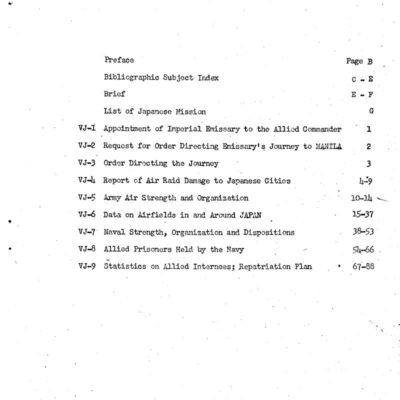
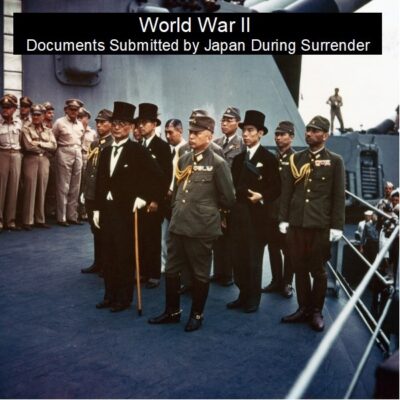
Japan’s Surrender Documents from World War II
$1.99 Add to Cart -
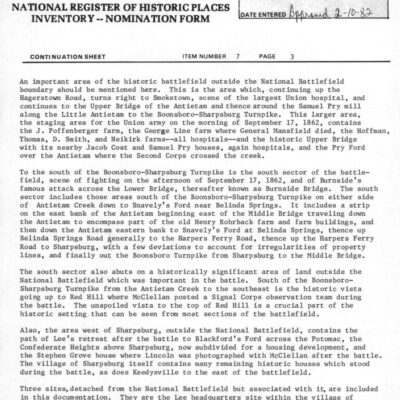
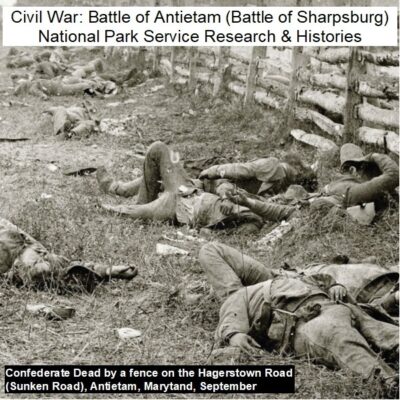
Civil War: Battle of Antietam (Sharpsburg) – National Park Service Archives
$9.99 Add to Cart -
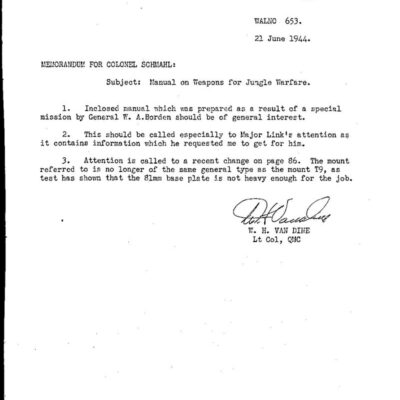
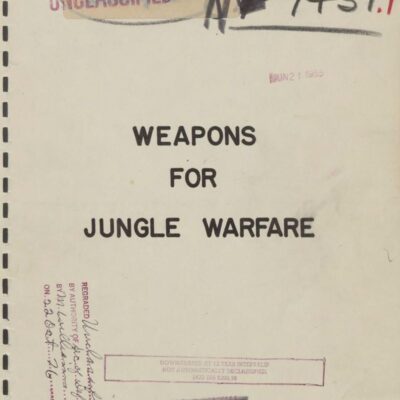
World War II Manual on Weapons for Jungle Warfare (1944)
$1.99 Add to Cart -

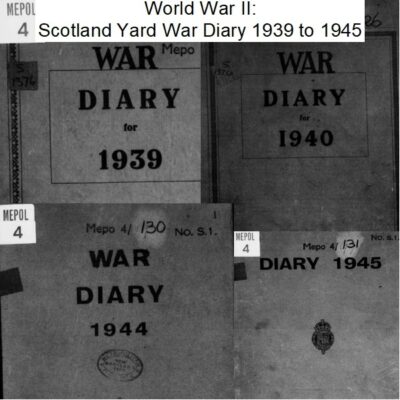
World War II: Scotland Yard War Diary from 1939 to 1945
$3.94 Add to Cart